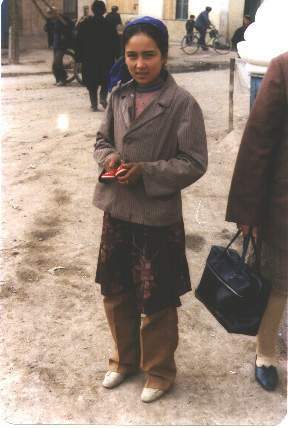
Here are my comments on you paper as well as suggested readings:
I bought a book a few month back titled "Return to Kashgar." I have not had time to read it (I have 400+ books and on top of that I am a student) but it looks like it may be of your interest. It is about a Swede named Gunnar Jarring who traveled to Kashgar in the 1929 and again in 1978. Jarring is supposedly an expert on the area. The book discusses Jarringís travels to Kashgar and the changes that took place during the 50 year interval between his two trips. The citation for this source is:

|
You mentioned northwestern Afghanistan and its relation to Turkestan. The northern tier of Afghanistan had traditionaly been a part of Central Asia and not the pashtun dominated south. It had especially strong ties with the Emirate of Bukhara, whose capital was in the city of Bukhara, which was carved up in the 1920ís into parts of Uzbekistan, Tukmenistan, Tajiksitan, and I believe Kazakhstan. In the 1880ís the pashtunís conquered what is today northern Afghanistan. Several independent states which had been independent for hundreds of years where absorbed by the Afghans during this conquest. In the 1890ís, I believe 1895, Afghanistan and Russia finalized the border between Russian Turkistan and Afghanistan. They used the Oxus/Amu-darya river as the dividing line. This river ran through the middle of several areas controlled by the Afghans in Badakhshan and in one of the areas controlled by Russian Turkistan. The Russians gave Afghanistan the southern half of the Darwaz region, which is now a part of the Badakhshan province in Afghanistan and the northern part is now a part of Central Tajikistan. The afghans in return gave up the eastern half of Roshan, Shugnan (sp), and the northern half of Wakhan. The southern half of Wakhan now is a part Wakhan corridor. To read more about this see
Becker, Seymour. Russiaís Protectorates in Central Asia: Bukhara and Khiva, 1865-1924. Harvard University Press Cambridge, Massachusetts. 1968.
You may also be interested in the fact that beginning in the 1870s the Chinese had troops in the Pamirs in what is now Gorno-Bakhshan, the eastern most province of Tajikistan. They were forced to with draw in the 1890s when the Russians entered the area. See the following to read about Chinese in the Pamirs:
Sheehy, Ann. "Russia and China in the Pamirs: 18th and 19th Centuries." Central Asian Review. Vol XXI 1968. Pages 4-14.
You mentioned that in northern Afghanistan and Uzbekistan Turkic is primarily spoken. Yes, Turkic is spoken in these areas but donít forget that in Uzbekistan there is a sizable Tajik speaking minority (as high as 30%. See: R. Foltz, "The Tajiks of Uzbekistan" Central Asian Survey, Vol. 15, No 2, 1996.) In Afghanistan the cities of Herat and Kabul have large Tajik populations. And of course donít forget Tajikistan, which conversely has a large Uzbek population which speaks a Turkish dialect.
You made some comments on the replacement of the Arabic script in Turkestan with Cyrillic. Actually Arabic was replaced in Soviet Central Asia in 1929 with the Latin alphabet and in 1938-40 it was replaced with Cyrillic. But it is important to remember that this was not just a Russian imposed idea, that is replacing the Arabic script. It was during the 19th century that native Central Asian scholars first began to ponder the replacement of Arabic script with either Cyrillic or Latin script in order to increase literacy. Actually literacy did dramatically increase in Central Asia during the Soviet era. Unfortunately for those who only know the Cyrillic script they were made functionally illiterate when it was replaced. See: Shorish, Mobin M. "Planning by Decree: The Soviet Language Policy in Central Asia." In the journal: Language Problems and Language Planning. Vol 8. No 1. Spr 1984. Pp 35-49.
You asked why did the Mongols kill every one. In a class I took about the history of Central Asia I was told that in Mongol religion it was believed that a Mongol warrior will control the soul of every person he kills therefore it was in their best interest to kill more and more. Also, the Mongols spared many cities in Central Asia, destroying only the resistive ones in order to make an example out of them. They spared cities which immediately capitulated.
=====================================================
**** David Straub ****
**** Tajikistan Update ****
*** http://www.angelfire.com/sd/tajikistanupdate ***
**** Stra0179@maroon.tc.umn.edu ****
=====================================================
Here are links: For more about the Uyghurs, see: